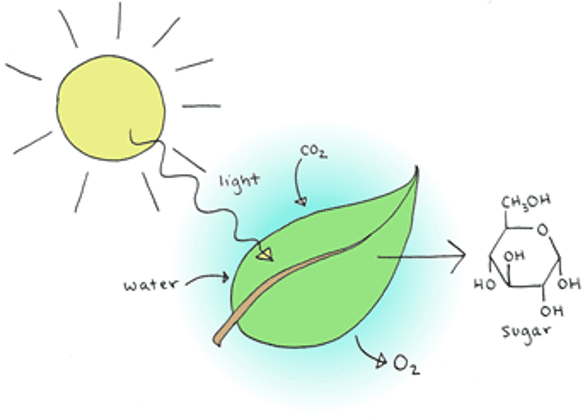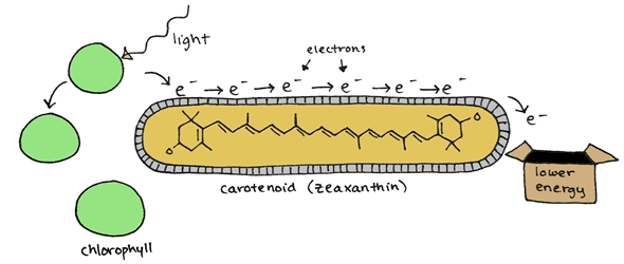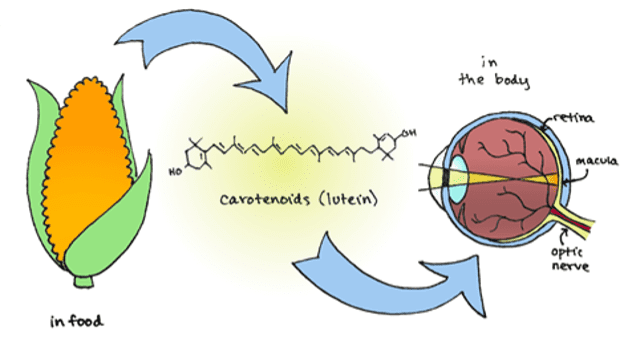
What are Carotenoids?
Professor Torbert’s corn gets its vivid orange hue from being naturally selected for significantly increased levels of antioxidant pigments called carotenoids.
So what exactly is a carotenoid? Unfortunately, the answer isn’t that simple. To begin with, carotenoids are the orange-colored pigments in plants. The more orange a food is, the more carotenoids it typically has (think carrot-enoids). These pigments perform several different functions in your body, but primarily help with protecting your eyesight as you age.
Where do Carotenoids Come From?
Carotenoids are made by plants and help them utilize energy more efficiently. Plants, as you may already know, use photosynthesis to generate their energy. Light hits their leaves, pigments absorb the light energy, and plants use it to make food.

The most well-known of these pigments is chlorophyll: it’s green and provides most plants with their color. Chlorophyll absorbs red and blue light, but reflects green light, hence the color. When a pigment like chlorophyll absorbs light, it suddenly has a lot more energy than it knows what to do with. This means the pigment is “excited.” To get rid of this energy, it shoots off an electron into the Electron Transport Chain, which uses the movement of the electron to make energy. Imagine a wind turbine: the electron is the wind that spins a turbine to create energy. Wind turbines make energy in the form of electricity, but plants make and store the energy in the form of sugar. The light excites an electron in the pigment, which shoots off and moves a turbine to create sugar.

But what if the pigment gets too excited? Or several get excited all at once? When a plant gets too much sun there are many electrons, and there is only so much space in the Electron Transport Chain. You then end up with an excess of excited electrons. This can result in excited electrons bouncing around with nowhere to go, causing a lot of damage. This is where carotenoids come in. Carotenoids are pigments like chlorophyll, except they are orange in color. They also have the ability to absorb and move these dangerous electrons away from where they might create problems, protecting the cell from damage (they’re antioxidants). When the chlorophyll gets a little overwhelmed, carotenoids work like molecular conveyor belts and move the electrons away from where they could do harm.

Furthermore, carotenoids can also absorb light, get excited, and provide electrons for the Electron Transport Chain like chlorophyll. However, because they are orange, they can access some of the energy from green light that chlorophyll can’t, helping the plant make even more sugar.
Fun fact: you can actually see a plant’s carotenoids every autumn! When a tree’s leaves turn orange, it is because green chlorophyll degrades faster than carotenoids, revealing the carotenoids and their bright orange, yellow, or red color.
How do Carotenoids Keep Us Healthy?
Carotenoids do a fantastic job protecting plants from excited electrons and giving them energy from green light that chlorophyll can’t absorb. So what do they do for humans? There are over 1000 types of carotenoids found in nature and they all perform different functions; however, the most commonly known carotenoids are lutein, zeaxanthin, and beta-carotene.
Lutein and zeaxanthin are very similar and work synergistically. They are the primary carotenoids in corn; the darker yellow or orange the corn is, the more lutein and zeaxanthin it contains. In humans, these two molecules are found primarily in the macular region of the eye, the part of your retina where the light shines the brightest. Carotenoids protect plants from light, so it makes sense they would protect us from light as well. This is exactly what lutein and zeaxanthin do for your eyes. They act as a shield and slow down cell degeneration caused by UV rays. Unfortunately, your body can’t make these molecules, so you have to get them from food. Studies have shown a diet higher in lutein and zeaxanthin can significantly lower your risk of age-related macular degeneration (AMD), which means lutein and zeaxanthin may help prevent sight loss as you get older. Therefore, a diet high in lutein and zeaxanthin is really good for your eyes!

Beta-carotene is another carotenoid that is good for you. It splits in your body and turns into two molecules of retinal, which is a kind of vitamin A. Like lutein and zeaxanthin, vitamin A supports eye health, but it also helps keep your skin healthy, and plays a role supporting your immune system. It’s easy to see the importance of vitamin A when looking at places in the world where it is not as readily available. In Sub-Saharan Africa, for example, many people suffer from vitamin A deficiencies. With less access to carotenoid-rich foods, these people are often heavily reliant on white corn, which provides essentially no carotenoids or vitamin A. This is evident in the large number of cases of childhood blindness, and deaths due to a weakened immune system. Simply replacing white corn crops with orange corn provides millions of people an opportunity to significantly improve their carotenoid and vitamin A intake.
In summary, carotenoids are orange pigments plants use to protect themselves from the sun. People need these carotenoids to protect themselves from the sun as well. Our bodies can also break some of them down into vitamin A, to keep our eyes and our immune systems healthy, making carotenoids and carotenoid-rich foods essential to a healthy diet.
So the next time you grab a bag of Professor Torbert’s Orange Corn know that in addition to being delicious, it also packs a greater nutritional punch due to its significantly increased levels of carotenoids. Try it today and taste the difference for yourself. Your body will thank you.
For more information on carotenoids check out these articles and resources:
Archives of Biochemistry and Biophysics – Carotenoids in human nutrition and health
